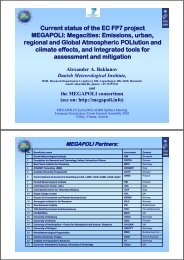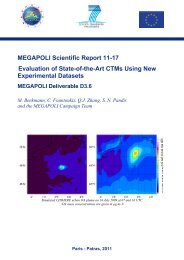D E S C R I P T I O N O F W O R K - MEGAPOLI - Dmi
D E S C R I P T I O N O F W O R K - MEGAPOLI - Dmi
D E S C R I P T I O N O F W O R K - MEGAPOLI - Dmi
Create successful ePaper yourself
Turn your PDF publications into a flip-book with our unique Google optimized e-Paper software.
<strong>MEGAPOLI</strong> 212520<br />
Expertise and experience of the organization<br />
NERSC is an independent non-profit research institute affiliated with the University of Bergen, Norway.<br />
NERSC conducts basic and applied environmental research funded by governmental agencies, research<br />
councils and industry. NERSC's research strategy is to integrate the use of remote sensing and field<br />
observations with local-, regional- and global-scale numerical modelling. NERSC staff teaches university<br />
courses and hosts graduate students and postdoctoral fellows from several nations. Faculty members at the<br />
Univ. of Bergen and senior staff at Nansen Center hold adjunct positions at the two institutions. NERSC is<br />
organized in 5 scientific units: Special Projects; Mohn-Sverdrup Center for Global Ocean Studies and<br />
Operational Oceanography; Coastal and Ocean Remote Sensing; Polar and Environ. Remote Sensing; G.C.<br />
Rieber Climate Institute. NERSC is a head institution of the Nansen Group, which includes establishments in<br />
Russia (Nansen Centre in S.-Petersburg), China (Nansen-Zhu Centre), India, South America and Africa to<br />
provide an impetus for globally-oriented research in support of sustainable development of the earths<br />
resources. In 2005, NERSC was awarded the prestigious European Descartes Prize for the best integrated<br />
research.<br />
Role and contribution<br />
In this project NERSC will be the co-leader of WP2 and the leader of its Task 4 – urban atmospheric<br />
boundary layer features, simulation, and parameterization. The primarily tools in operation will be<br />
turbulence-resolving models, namely, the NERSC LES code and parallelized LES code of the<br />
Meteorological Institute at Hannover University. With these tools, NERSC will contribute in understanding<br />
and simulations of the Paris plume (WP3) and the development of improved UABL parameterizations for<br />
WP4-6. Ultimate contribution will aim at representation of the urban climate and pollution through a 3D<br />
visualization of urban atmospheric dynamics in WP7.<br />
Principal personnel involved<br />
Dr. Igor Esau – is a staff member of NERSC since 2003. He has graduated Tomsk University with honour<br />
degree in 1992 and defended two Ph.Ds.: one in the area of numerical mathematics in 1996 at the Russian<br />
Institute for Numerical Mathematics, Moscow; and another in the area of turbulence modelling in<br />
meteorology in 2003 in Swedish Uppsala University, Uppsala. Dr. Esau is currently working in the area of<br />
application of the turbulence-resolving modelling to studies of local climate forming processes, especially<br />
over heterogeneous surfaces similar to urban heat islands. This project is just a natural continuation of his<br />
long-term research priorities and sevrbulence-resolving modelling. He is currently supervising 2 Ph.D.<br />
programmes. He has published 21 peer-review articles, of which 16 during the last 5 years.<br />
Selected relevant publications<br />
Esau, I., Zilitinkevich, S.S., (2006): Universal Dependences between Turbulent and Mean Flow Parameters in Stably<br />
and Neutrally Stratified Planetary Boundary Layers, Nonlinear Processes in Geophys., 13, 122-144.<br />
Beare, R. J., I. Esau, and 15 co-authors, (2006): An intercomparison of large-eddy simulations of the stable boundary<br />
layer, Boundary Layer Meteorology, 118(2), 2, 247-272.<br />
Esau, I., (2006): An improved parameterization of turbulent exchange coefficients accounting for the non-local effect<br />
of large eddies, Annales Geophysicae, 22, 3353-3362.<br />
Esau, I., (2006): Simulation of Ekman boundary layers by large eddy model with dynamic mixed subfilter closure,<br />
Journal of Environmental Fluid Mechanics, 4, 273-303.<br />
Esau, I., Lyons T. J., (2002): Effect of sharp vegetation boundary on the convective atmospheric boundary layer,<br />
Agricultural and Forest Meteorology, 114(1-2), 3-13.<br />
Partner 12: Norwegian Institute for Air Research (NILU)<br />
Expertise and experience of the organization<br />
The NILU is an independent research foundation specialising in air pollution research from global to local<br />
problems and today is one of the largest European institutes in this field. NILU is the Chemical Coordinating<br />
Centre for EMEP and coordinates the work under the Convention on Long-Range Transboundary<br />
Air Pollution on particulate matter. NILU is a member of the European Environment Agency’s Topic Centre<br />
on Air Quality and Climate Change. NILU has 30 years experience in ambient trace gas measurements.<br />
NILU has been involved in several recent or current EC-research projects relevant to the <strong>MEGAPOLI</strong><br />
proposal, such as EUCAARI, EUSAAR, CREATE, EARLINET-ASOS, Retro, SCOUT-O3, GMES-GATO,<br />
FORMAT, ASSET, FUMAPEX, Air4EU and ACCENT. NILU is also a member of the Nordic Centre of<br />
Excellence CBACCI (Biosphere – Atmosphere - Clouds – Climate – Interactions).<br />
Role and contribution<br />
Implementation and application of subgrid emission parameterisations for selected megacities for use in air<br />
quality and exposure assessment. Participation in urban scale ensemble model analysis using the AirQUIS-<br />
81




